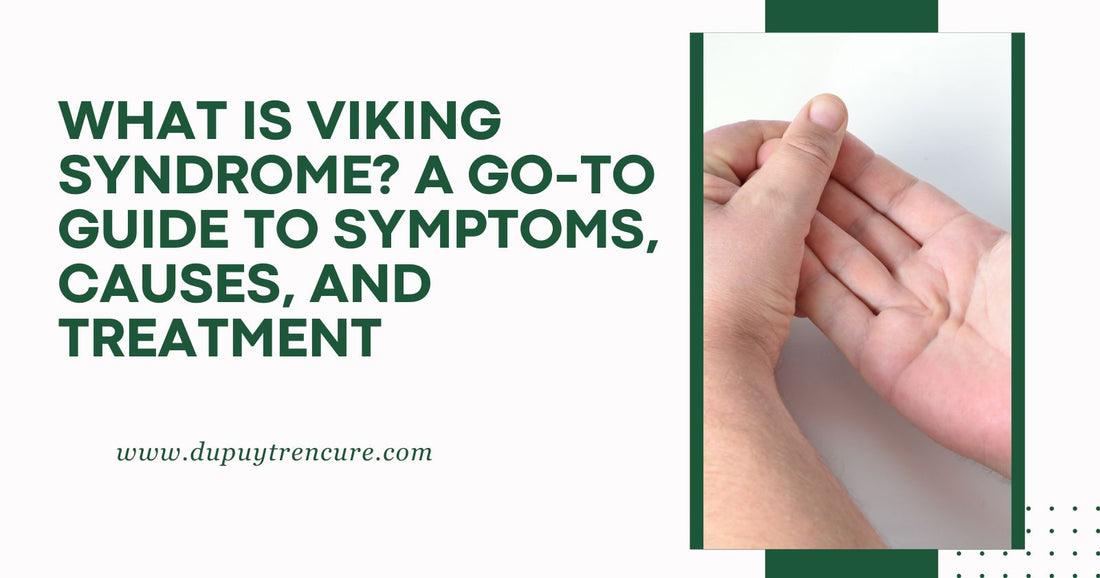Dupuytren’s Contracture or Viking Syndrome is a medical condition that causes hand deformity. It occurs very slowly as soft tissues under the skin start to thicken. As a result, the fingers of the person start to bend towards the palm because of the knot formation. The most affected fingers are generally the middle, ring finger, and pinkie. While the index is affected too, the disease hardly spreads through the thumbs. And while some people suffer from this condition in both hands, it generally affects one hand more prominently than the other.
When the Viking’s disease symptoms get severe, it significantly restricts the ability to perform activities in the daily life of a person, such as personal sanitation, holding items, and working with their hands.
Why is Dupuytren’s Contracture Called Viking Disease?
Dupuytren’s Contracture or Viking Syndrome is also known as Viking’s Disease. This nickname comes from oral history tracking back to the Vikings. Tradition says that they had spread it all over northern Europe.
The first person to treat a patient with this condition was Dr. Guillaume Dupuytren. He was believed to be one of the most known surgeons in Europe, and after publishing a detailed research paper on this condition, Viking’s Disease was named after him.
What Causes Viking’s Disease?
Now that we know what Viking syndrome is, let us move forward to the cause of this condition. Node formation of the connective tissues in the palm causes Viking’s disease. The tissues are formed between the skin and the muscles of the palm. The connective tissue grows as a band, pulling the affected fingers in a bent position towards the palm.
Factors that cause such irregular node formation of connective tissues are unknown. Though this condition is hereditary, it is believed that genetics play the main role in the cause of this disease. It is common in people coming from North Europe. Many scholars believe that the trauma or injury in the palm can also lead to abnormal node formation in the connective tissues. No relation between the factors like the intensive manual work, typing job, or use of vibrating tools and development of this condition has been found so far.
What are the Symptoms of Dupuytren’s Contracture?
Viking’s disease symptoms appear slowly and in phases. The different stages of development of this disease are as below:
Nodules: Small lump of mass appears on the upper layer of the palm. At first, these lumps are sore to the touch, but the soreness typically goes away as the disease progress.
Bands of tissues/ Cord: The nodules start to get thick and then contract, forming the bands of tissue, known as cords. These hard bands exist under the skin and are observed as thick and raised coatings.
Curled fingers: One or more finger starts to bend towards the palm. Over time, it develops more and causes difficulty when trying to uncurl the fingers. The condition usually affects the ring finger first, then the little finger, and then the middle finger. In rare cases, it affects all the fingers together with the thumb.
Treatment
There is no specific cure for Dupuytren’s Contracture, but the condition is not linked to mortality.
Although it differs from patient to patient, Dupuytren’s generally develops slowly and may not become bothersome for years.
If the disease develops, your doctor first will recommend a nonsurgical treatment to help slow down the development or consequences of this disease.
Nonsurgical treatment
Dupuytren’s Wand: Using the Dupuytren’s Wand followed by wearing Dupuytren’s tape provides a consistent and comfortable stretch to the finger that helps to slowly restore the range of motion.
Steroid injection. Steroids that are injected are powerful anti-inflammatory medicines. In many cases, the injection slows the development of a contracture. The success of a steroid injection differs from patient to patient.
If the disease interferes with hand movement, your doctor will recommend surgical treatment. This surgery aims to decrease the Contracture and bring back the motion in the affected fingers.
Now you have detailed information on what is Viking’s disease, its causes, symptoms, and treatment options; the next step is to speak with your physician.

